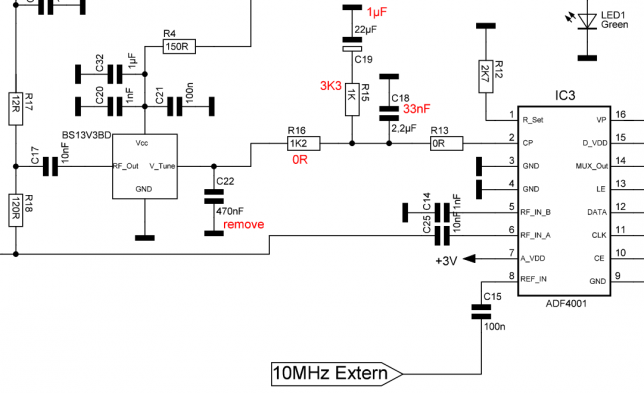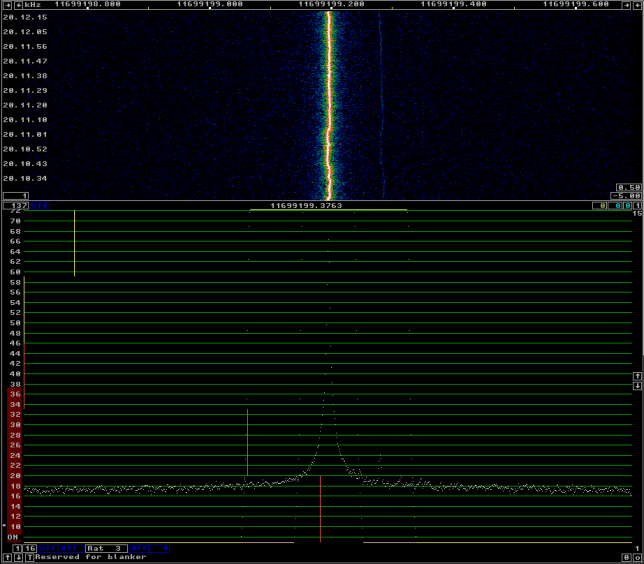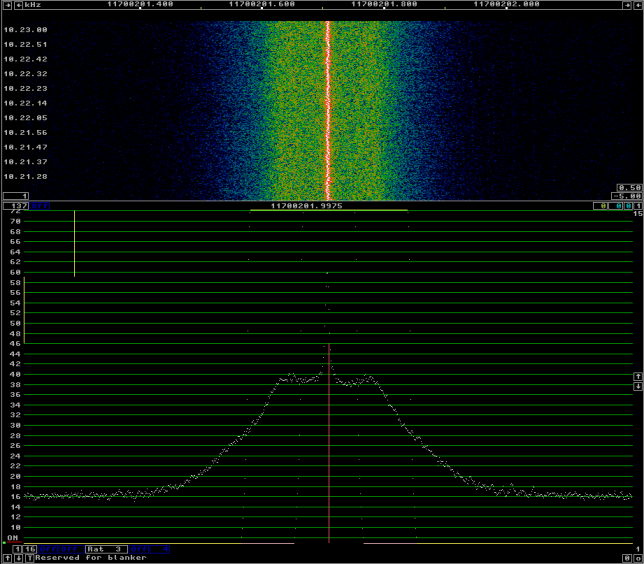Lately, I have been trying to make an amplitude and phase calibration of my Hermes-Lite 2 beta2 in order to use Linrad’s smart noise blanker. This is quite a task because Linrad doesn’t support the Hermes-Lite 2 directly. Today I’ve finally managed to do it. Here I describe all my setup and calibration results.
Category: Hardware
Designing, building and testing amateur radio hardware.
Testing a simple pulse generator for Linrad calibration
Lately, I’ve being talking with Juan Antonio EA4CYQ and Pedro EA4ADJ about performing Linrad calibration to enable the use of the smart noise blanker. They pointed me to the SIGP-1 by Alex HB9DRI, which is a 144MHz pulse generator with which I was already familiar, and a simpler pulse generator by Leif SM5BSZ which I hadn’t seen before.
Leif’s generator is very simple. It uses a 555 timer to generate a square wave, a 74AC74 flip-flop to divide the frequency of the square wave by 2 and obtain a precise 50% duty cycle, a 74AC04 inverter as a driver, and capacitive coupling to turn the edges of the square wave into RF pulses. Alex’s SIGP-1 is an improvement over Leif’s design. It generates the square wave in the same manner, but then it uses a helical bandpass filter for 144MHz with around 5MHz bandwidth to convert the square wave into 144MHz pulses, and a PGA-103+ MMIC RF amplifier and a BFR91 RF NPN transistor as a class A amplifier to increase the output level. The SIGP-1 has two main advantages over Leif design. The output is stronger, so the S/N of the pulses is higher, and the filtering helps prevent saturation in the receiver. However, Leif’s design uses only simple components and it’s adequate in many cases.
I have built and tested Leif’s generator and used it to calibrate my FUNcube Dongle Pro+ at 144MHz. I’ve also tried doing the calibration at other frequencies and it also works well, but the pulses are not very strong at 432MHz and above.
Improving phase noise performance of the DF9NP 27MHz PLL
In some of the latest posts, I’ve being talking about the phase noise performance of 10GHz receivers, and in particular, of 27MHz references for Ku-band LNBFs (1, 2, 3, 4). Indeed, this started when I checked the performance of my new 10MHz GPSDO and 27MHz PLL by DF9NP and I wasn’t too happy with the phase noise.
After working with Dieter DF9NP in investigating this problem and performing several tests, Dieter found that the problem was likely in the loop bandwidth of the 27MHz PLL. The loop filter bandwidth is 50kHz. He proposed the following component modifications to change the bandwidth to 300Hz.
Update 2018-10-21: Dieter tells me that this problem has been solved in the new units he is selling, so the performance of the new units should be good.

After I performed the modifications, I was quite surprised and happy with the results. As always, I’ve used the beacon of BADR-5 at 11966.2MHz to test the phase noise performance. Linrad’s AFC is in use. The result is below. As you can see, it is as good as the best references that I had tested before.

For comparison, this was the performance before the modification. The difference is huge. Many thanks to Dieter for his effort and to Luis EA5DOM, who also participated in the discussion and gave some good advice.

Using the CC1101 and Beaglebone black for IP traffic on 70cm
Lately, I have been experimenting with using a CC1101 chip together with a Beaglebone black single board ARM computer to transmit IP traffic over the 70cm Amateur band. There has been a similar project from OEVSV, but I’ve never seen this project reach a final form. Edouard F4EXB has some code that uses the Raspberry Pi instead. Presumably, this will suffer from problems when using the higher data rates supported by the CC1101, as his software is not real-time.
The goal of my project is to build an affordable 70cm IP transceiver with a power of a few Watts. This can be used in the Hamnet Amateur Radio IP network. The modulation should not use more than a couple of hundreds of kHz’s of spectrum, as it doesn’t seem very sensible to take up much more spectrum in the 70cm band. Although the usual maximum bandwidth in the 70cm band is 20kHz, the IARU R1 bandplan allows for wideband experiments around 434.000MHz. A data rate of 128kbps with MSK modulation seems about right, as it uses roughly 200kHz of spectrum. Further on-the-air tests will perhaps change these parameters a bit.
Adjusting TX gain in the FT-817ND
If you’ve been following my latests posts, you’ll know that during the last V-UHF contest I detected reduced output power on the 70cm band in my FT-817ND. The output power was only about 60% of the maximum 5W in SSB and CW, but in FM mode it reached 5W. This problem only happened on the 70cm band. On all the other bands, the radio reached 5W output power in every modes. After spending some time studying the service manual, I came to the conclusion that the problem was that TX gain in the UHF band was too low. This is a software calibration parameter, so, in the end, fixing this problem has been rather easy.
Replacing the fuse F1002 in the FT-817ND
On last Saturday’s V-UHF contest I observed reduced output power on the 70cm band in my FT-817ND. I spent the next day poking inside the radio with the oscilloscope trying to see where the problem was. While doing this, at some point I completely lost output power in all bands. I found that the problem was that F1002, an SMD fuse, had gone open. Here I describe said fuse and the replacement procedure, which I found much easier than I thought.
Building the OCXO/Si5351A kit from QRP Labs
Some posts ago, I spoke about the possibility of using the OCXO/Si5351A synth kit from QRP Labs as a low cost way of providing an external stable 27MHz reference to a satellite LNBF. I’ve received and built my kit some days ago, so here I will be looking at some aspects in the construction and performance of this kit.
Calibrating the S-meter in Linrad
In a previous post, I talked about the GALI-39 amplifier kit from Minikits. Here I will describe the procedure to calibrate the S-meter in Linrad (or another SDR) using this amplifier or any other amplifier with a known NF and an uncalibrated signal source. Leif Åsbrink has a youtube video where he speaks about the calibration of the S-meter in Linrad. However, he doesn’t use an amplifier, so I will be following a slightly different procedure.
Building the GALI-39 amplifier kit from Minikits
The GALI-39 is a DC-7GHz MMIC amplifier from Minicircuits. This device has a gain around 20dB and a NF of about 2.4dB. The nice thing about MMICs is that their input and output impedances are matched to 50Ω, so it’s quite easy to work with them. Minicircuits makes many MMIC amplifiers suiting different needs, but unfortunately their products are not so easy to get in small quantities.
Minikits.com.au is an Australian store that sells Minicircuits parts in small quantities as well as many interesting RF kits. I needed some RF amplifier having a known NF to do some signal level calibrations, so I ended up ordering the GALI-39 amplifier kit from Minikits. This kit includes just the GALI-39, a PCB and the handful of SMD components you need to bias the amplifier. At 22AUD, the price of the kit is about right and buying the kit instead of just the GALI-39 saves me to do the shopping for the assorted SMD components and using the PCB instead of botching some circuit is always nice, because the PCB uses microstrip transmission line (but the substrate is regular FR-4). Here I have a look at what is included in the kit (I’ve been unable to find a complete list on Minikit’s web).
An idea for a low cost stable 10GHz receiver
The satellite Es’Hail-2 is expected to be launched by the end of 2016. This will be the first geostationary satellite carrying an amateur radio transponder. As the launch date comes nearer, it becomes interesting to find a low cost solution to receive its 10GHz downlink.
Several amateurs have been experimenting with low cost LNBFs designed to receive satellite TV. These operate in the Ku band and usually cover the frequencies 10.7GHz-12.75GHz. However, many of these LNBFs have also good performance in the X band, and particularly in the amateur 10GHz band (10GHz-10.5GHz). In fact, the ASTRA-type LNBFs have a local oscillator which can be setted to either 9.75GHz or 10.6GHz. The 9.75GHz local oscillator mixes 10.386GHz (the narrowband terrestrial subband) to 618MHz, which is a frequency covered by most SDRs and conventional scanners. The satellite subband, which is 10.45GHz-10.5GHz gets mixed down to 700MHz-750MHz, a frequency which is also easy to deal with.